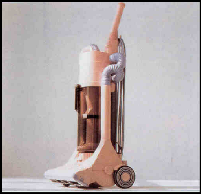




12th November 2010
Engineers & Engineering

James Dyson spent many some years working in the field of Industrial air-cleaning and realised that some of the principles he had used there could be
applied to domestic cleaners. He produced 5,127 prototypes of his ‘cyclone’ cleaner before it finally went into production. The bright and synthetic colours of the units show that the product is not meant to be placed out of sight in a cupboard. It is to be regarded as an attractive object as well as being functional.

1993
1986


engineering principles involved required significant patent protection - and yet this protection has to - and did in Dyson's case - be funded from a business income that ( in many similar cases too) - has not yet begun to grow. Patents require continuous renewing to afford full
protection and it wasn't too long before rival cleaner companies copied the design principles requiring the Dyson company to protect the engineering principles in court.
One of James Dyson's earlier successes was the invention of the 'Ballbarrow' the design giving greater mobility in turning and greater stability on softer ground.

Cardboard modelling is an important part of the design and engineering process. It is also inexpensive and a realistic way of checking if something you have designed will work. James Dyson’s ‘Cyclone Kit’ allows you to make your own cyclone from cardboard and which when connected to a vacuum cleaner demonstrates how centrifugal force works.
Teaching Resources ?


